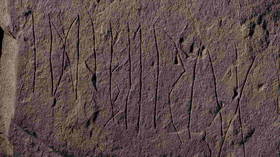Norway makes fascinating discovery


A team of Norwegian archeologists has found what they call the oldest rune stone known to date. The small, brownish rock carved with mysterious inscriptions is said to date back to the time of Jesus Christ and to be some 2,000 years old.
“The up to 2,000-year-old inscriptions are from the very oldest period in the enigmatic history of runic writing,” the Museum of Cultural History in Oslo, which was the first to break the news this week, said in a press release.
A small piece of sandstone was found as the team was examining an ancient burial ground near the lake of Tyrifjorden, just northwest of the Norwegian capital of Oslo, in late 2021. According to the Oslo museum, the runes on the stone are “the oldest known writing in Norway.” The author of the runes “spoke an ancient language that is considered the precursor to Old Norse,” the parent language of all Nordic tongues spoken today, the statement added.
The stone has several types of engravings, the museum said, adding that not all of them “make linguistic sense.” Several runes clearly stand out among other inscriptions, forming the word “idiberug,” the statement said. But the scientists have so far failed to confirm its exact meaning, believing it might have stood for the name ‘Idibergu’ or the family name ‘Idiberung’.
Carbon dating of bones and wood discovered in the burial ground near the rune stone suggests that it was inscribed between 1 and 250 AD, when the ancient Roman Empire was on the rise and Christianity was taking its first steps. According to some media reports, the stone is also centuries older than all of the other rune stones previously discovered.
“This find will give us a lot of knowledge about the use of runes in the early iron age. This may be one of the first attempts to use runes in Norway and Scandinavia on stone,” Kristel Zilmer, a professor at the University of Oslo, told AP. She also called the discovery “the most sensational thing that I, as an academic, have had.”
Runic alphabets were in use by the Germanic peoples, including the Scandinavians, before they adopted the Latin alphabet. Some forms of runic writing were still used in Scandinavia throughout the Middle Ages and the Swedish province of Dalarna kept this form of writing up until the 20th century.